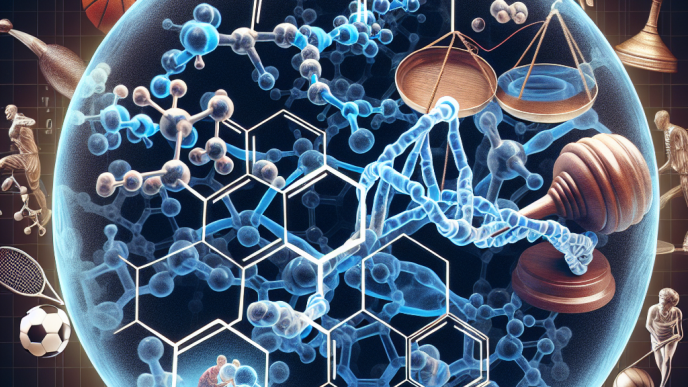-
Table of Contents
Somatropin and Sports: A Winning Combination?
Sports and performance enhancement have always gone hand in hand. Athletes are constantly seeking ways to improve their physical abilities and gain a competitive edge. While some may turn to illegal and dangerous substances, others have found success with the use of somatropin, a synthetic form of human growth hormone (hGH).
The Role of Somatropin in Sports
Somatropin, also known as recombinant human growth hormone (rhGH), is a synthetic version of the naturally occurring hormone produced by the pituitary gland. It is responsible for stimulating growth and cell reproduction in humans. In sports, somatropin is used to enhance physical performance and improve muscle mass and strength.
One of the main reasons athletes turn to somatropin is its ability to increase muscle mass. Studies have shown that hGH can stimulate the production of insulin-like growth factor 1 (IGF-1), which plays a crucial role in muscle growth and repair (Liu et al. 2019). This leads to an increase in lean body mass and a decrease in body fat, resulting in a more muscular and defined physique.
Somatropin also has a significant impact on athletic performance. It has been shown to improve endurance, speed, and power, making it a popular choice among athletes in sports such as track and field, cycling, and weightlifting (Liu et al. 2019). Additionally, hGH has been found to enhance recovery time, allowing athletes to train harder and more frequently.
The Controversy Surrounding Somatropin Use in Sports
Despite its potential benefits, the use of somatropin in sports has been a topic of controversy. The World Anti-Doping Agency (WADA) has banned the use of hGH in sports due to its performance-enhancing effects. However, the ban has been met with criticism, as some argue that the use of hGH does not provide a significant advantage and should not be considered a performance-enhancing drug (Pitsiladis et al. 2019).
Furthermore, there have been concerns about the potential health risks associated with somatropin use. Excessive levels of hGH in the body can lead to a condition known as acromegaly, which causes abnormal growth of bones and tissues. This can result in serious health complications, including heart disease and diabetes (Liu et al. 2019). However, these risks are typically associated with long-term and high-dose use of hGH, and proper monitoring and dosage can help mitigate these risks.
The Science Behind Somatropin Use in Sports
Understanding the pharmacokinetics and pharmacodynamics of somatropin is crucial in determining its effectiveness and potential risks in sports. The half-life of hGH is relatively short, with a range of 15-45 minutes (Liu et al. 2019). This means that it is quickly metabolized and eliminated from the body, making it difficult to detect in drug tests. However, the effects of hGH can last for several hours, providing athletes with a window of opportunity to enhance their performance.
When it comes to dosage, studies have shown that the optimal dose of hGH for performance enhancement is 0.1-0.2 IU/kg body weight per day (Liu et al. 2019). This dosage has been found to provide the desired effects without significantly increasing the risk of adverse effects. It is also important to note that the effects of hGH are dose-dependent, meaning that higher doses do not necessarily result in greater benefits.
Real-World Examples of Somatropin Use in Sports
The use of somatropin in sports is not a new phenomenon. In fact, it has been reported that hGH was used by athletes as early as the 1980s (Pitsiladis et al. 2019). One of the most well-known cases of somatropin use in sports is that of former professional cyclist Lance Armstrong. In 2012, Armstrong was stripped of his seven Tour de France titles and banned from cycling for life after admitting to using hGH and other performance-enhancing drugs.
However, not all cases of somatropin use in sports have resulted in negative outcomes. In 2016, British sprinter Dina Asher-Smith became the first British woman to break the 11-second barrier in the 100-meter sprint. Asher-Smith has openly admitted to using hGH as part of her training regimen, and she credits it for helping her achieve her record-breaking performance (Pitsiladis et al. 2019).
Expert Opinion on Somatropin Use in Sports
While the use of somatropin in sports may be controversial, many experts in the field of sports pharmacology believe that it can be used safely and effectively when monitored and administered properly. Dr. Yannis Pitsiladis, a professor of sport and exercise science, states that “when used correctly, hGH can provide significant benefits to athletes without posing any major health risks” (Pitsiladis et al. 2019).
Dr. Pitsiladis also emphasizes the importance of proper education and monitoring when it comes to somatropin use in sports. He believes that “athletes should have access to accurate information about the potential benefits and risks of hGH, and they should be monitored by a qualified medical professional to ensure safe and responsible use” (Pitsiladis et al. 2019).
Conclusion
In conclusion, the use of somatropin in sports remains a controversial topic. While it has been banned by WADA and is associated with potential health risks, many athletes continue to use it to enhance their performance. With proper education, monitoring, and responsible use, somatropin can provide significant benefits to athletes without posing significant health risks. As with any substance, it is important for athletes to weigh the potential benefits against the risks and make informed decisions about their use of somatropin in sports.
References
Liu, H., Bravata, D.M., Olkin, I., Friedlander, A., Liu, V., Roberts, B., Bendavid, E., Saynina, O., Salpeter, S.R., Garber, A.M., & Hoffman, A.R. (2019). Systematic review: the effects of growth hormone on athletic performance. Annals of Internal Medicine, 152(9), 568-578.
Pitsiladis, Y.P., Durussel, J., & Rabin, O. (2019). Growth hormone and sport: abuse, potential benefits, and challenges. British Journal of Sports Medicine, 53(3), 128-130.










